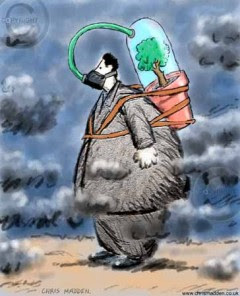
Automobile pollution is the amount of emissions produced by different automobiles running on roads. Increasing levels of air pollution from these automobiles especially passenger cars have become a real threat to the Indian populace as well as the environment.
In India, commercial vehicles and passenger cars are believed to contribute maximum to environmental pollution. Today, as the awareness of people regarding environmental pollution is consistently increasing, they are gathering up ways and measures to control pollution especially that from passenger cars.
Indian car manufacturers like Maruti Suzuki, Hyundai, and Honda are continuously working on greener technologies to help keep the environment clean and give a green world to their valued customers as well as the others in the country who don't even own cars.
Common Car Pollutants
The key component responsible for car pollution is the combustion engine. Getting the combustion engine in a car going requires a mixture of air and fuel to be burnt within the engine's cylinders. The petrol used in this mixture is composed of hydrocarbons, carbon monoxide, and nitrogen oxide. The unburnt quantity of these gases in the combustion engine emit out as pollutants.
Car pollution is increased further if the car is not tuned and maintained properly. The car should be regularly checked and maintained in order to keep the emission levels at minimum.
Key car pollutants that have a negative effect on the environment are:
- Carbon Monoxide: Carbon monoxide is a poisonous gas produced in the internal combustion engine. More of this poisonous gas is produced if the air to fuel ratio is low. The key factor responsible for increased production of carbon dioxide is irregular maintenance of car engine. It is also said that cars produce about 90% of the total carbon monoxide content that majorly contributes to environmental pollution.
- Nitrogen Oxide: Nitrogen reacts with oxygen atoms when there is high pressure and high temperature. Both these atoms react together to form nitrogen oxide that is one of the most harmful gases for both the environment as well as human. These are also believed to contribute to acid rain formation and about 72% to global warming.
- Hydrocarbon: These are composed of hydrogen and water and are produced during combustion. Composed of different molecular weight substances, these often pose a great risk to human as well as the environment.
Modern cars use catalytic convertors to reduce emissions from passenger cars. At present, the situation is gradually taken care of by these convertors but long term solutions will have to be conceived to have a safer environment.
Innovative new technologies are paving the way for alternative sources of fuels that produce lower emissions. The recent trend includes the usage of Liquefied Petroleum Gas (LPG) and
Compressed Natural Gas (CNG). For the future, car manufacturers are also eyeing water and air as possible sources of energy to drive cars.
